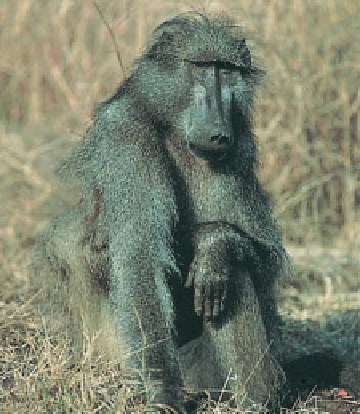Geology Reference
In-Depth Information
Kenya, by Meave Leakey of the National Museums of Kenya
and her colleagues, this 4.2-million-year-old bipedal species
has many features in common with its younger relative,
Australopithecus afarensis,
yet is more primitive in other
characteristics, such as its teeth and skull.
A. anamensis
is es-
timated to have been between 1.3 and 1.5 m tall and weighed
33 to 50 kg.
A discovery, reported in 2006, of fossils of
Australopithecus
anamensis
from the Middle Awash area in northeastern Ethio-
pia has shed new light on the transition between
Ardipithecus
and
Australopithecus
. Prior to this discovery, the origin of
Aus-
tralopithecus
has been hampered by a sparse fossil record. The
discovery of
Ardipithecus
in the same region of Africa and at
the same time as the earliest
Australopithecus
provides strong
evidence that
Ardipithecus
evolved into
Australopithecus
and
links these two genera in the evolutionary lineage leading to
humans.
Australopithecus afarensis
(
TABLE 23.2
Classifi cation of the Primates
Order Primates: Lemurs, lorises, tarsiers, monkeys, apes,
humans
Suborder Prosimii: Lemurs, lorises, tarsiers (lower primates)
Suborder Anthropoidea: Monkeys, apes, humans
(higher primates)
Superfamily Hominoidea: Apes, humans
Family Hominidae: Humans
species are recognized:
A. anamensis, A. afarensis, A. africanus,
A. robustus,
and
A. boisei.
Many paleontologists accept the
evolutionary scheme in which
A. anamensis,
the oldest
known australopithecine, is ancestral to
A. afarensis,
who
in turn is ancestral to
A. africanus
and the genus
Homo,
as
well as the side branch of australopithecines represented by
A. robustus
and
A. boisei.
The oldest known australopithicine is
Australopithecus
anamensis.
Discovered at Kanapoi, a site near Lake Turkana,
Figure 23.33), who lived 3.9-
3.0 million years ago, was fully bipedal and exhibited great
variability in size and weight.
Members of this species ranged
from just over 1 m to about
1.5 m tall and weighed between
29 and 45 kg. They had a brain
size of 380-450 cubic centimeters
(cc), larger than the 300-400 cc
of a chimpanzee, but much
smaller than that of present-day
humans (1350 cc average).
The skull of
A. afarensis
retained many apelike features,
including massive brow ridges
and a forward-jutting jaw, but its
teeth were intermediate between
those of apes and humans. The
heavily enameled molars were
probably an adaptation to chew-
ing fruits, seeds, and roots.
A. afarensis
was stratigraphi-
cally succeeded by
Australo-
pithecus africanus,
who lived
3.0-2.3 million years ago. The
differences between the two spe-
cies are relatively minor. They
were both about the same size
and weight, but
A. africanus
had a
fl atter face and a somewhat larger
brain (
◗
◗
Figure 23.29
Primates Primates are divided into two suborders: the prosimians
a
and the
anthropoids
(
-
)
, which are further subdivided into Old World monkeys
b
New World monkeys
c
and hominoids, which include the apes
d
and humans.
b
d
a
Tarsier
Baboon
b
Figure 23.34). Further-
more, it appears that the limbs
of
A. africanus
may not have been
as well adapted for bipedalism as
those of
A. afarensis
.
Both
A. afarensis
and
A. africanus
differ markedly
from the so-called robust species
A. boisei
(2.6-1.0 million years ago)
and
A. robustus
(2.0-1.2 million
◗
c
Spider monkey
Chimpanzee
d













Search WWH ::

Custom Search